Photos with this report (click to enlarge) | |||
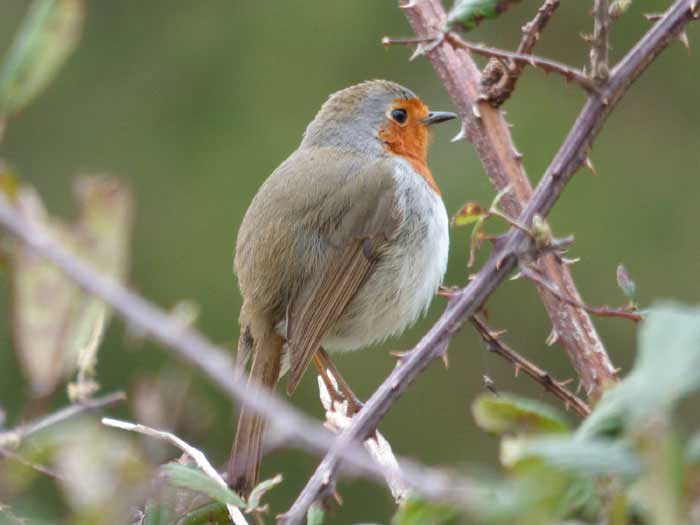 Tenerife Robin |
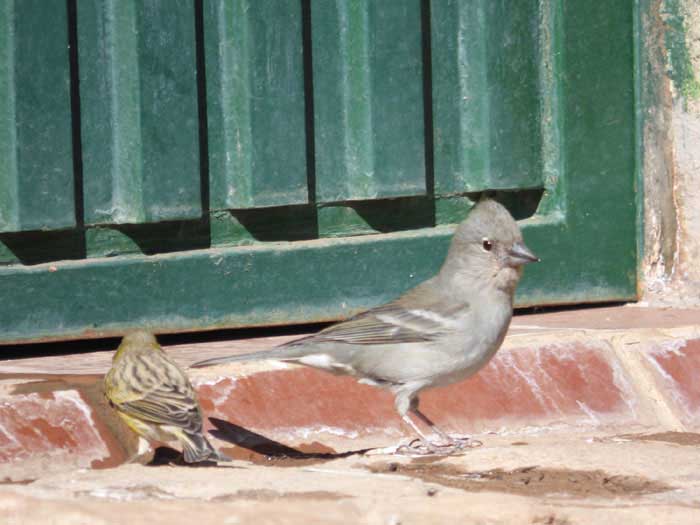 Blue Chaffinch (female) |
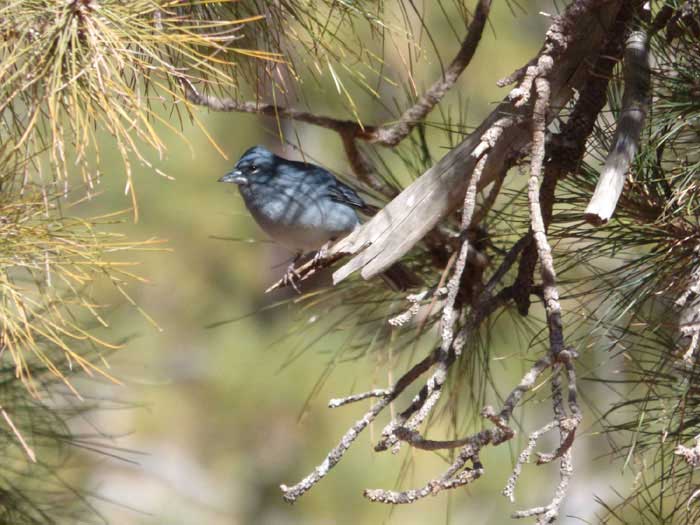 Blue Chaffinch (male) |
|
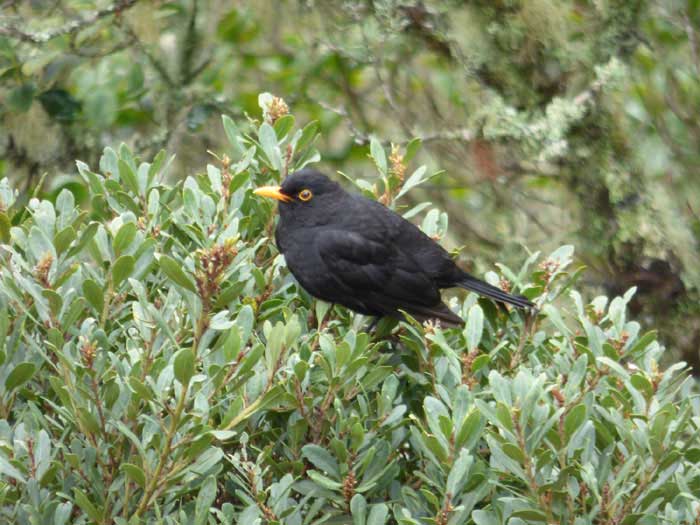 Blackbird (T.m.cabrerae) |
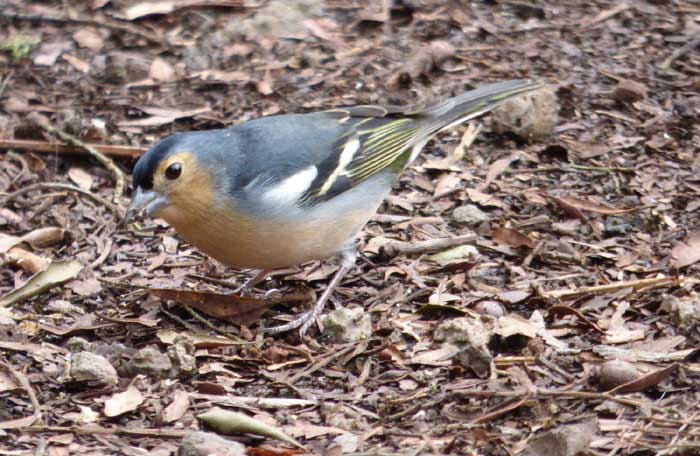 Chaffinch (F.c.canariensis) |
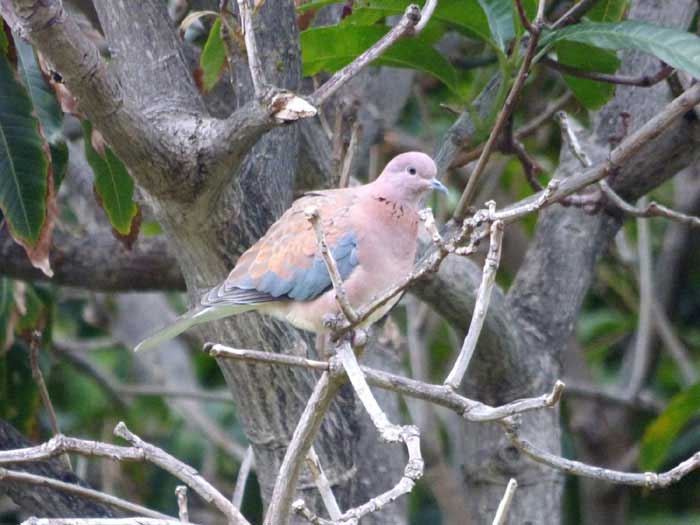 Laughing Dove |
|
The Canaries are a favourite of ours during January/February when conditions at Land’s End in Cornwall where we live are just not nice! Thus, even though we have been to most of the large islands previously including Tenerife in 1999, they still draw us back time and again for the wonderful scenery, weather and endemic flora and fauna across the archipelago. It was 22 degrees Celsius when we arrived and even reached 25 one day.
On our previous visit to Tenerife 19 years ago we stayed at the busy tourist complex at Playa de las Americas in the south. It was our first family holiday abroad with our children Heidi and Lucas and a cheap package deal but looking back we didn’t sleep much at our noisy hotel and really only used it as a base from which to explore the island by hire car and local buses. This time round we decided to book our own apartment well away from here – in the small village of Radazul in the north east and with sea views from the balcony for my scope, this proved to be a better solution for the peace and quiet we were seeking. With our hire car and the great new road network we still managed to see most of the island although our second week, being cooler with showers, saw us driving the 60km south most days to the warmer climes associated with southern Tenerife. Petrol is still cheaper than the UK though @ 83p/litre and most of the coast road is motorway with a speed limit of 120kmh so it doesn’t take long!
This was a relatively expensive holiday for us and the pound is weak at the moment with an exchange rate £1 = Euro 0.92 but it was still worth every penny. We flew from Exeter to Tenerife South Airport for £809 (£270 ea) with Tui Airways - but this included excess baggage payment for two suitcases £110. Flights from Gatwick or Heathrow are always cheaper but living in west Cornwall usually require overnighters both ends plus the long drive up and back. Airport parking at Exeter was £66 for two weeks so quite reasonable. We booked a hire car with Hertz for £323 (we decided to pay an extra 2 Euros/day for an upgrade and as we covered 1,750km in the two weeks I’m pleased we did) and spent c£80 on fuel. Our 2-bedroomed holiday apartment in Radazul was £858 for 14 nights. Food and drink remain much cheaper than the UK so if we hadn’t been so “extravagant” with the above, we would have spent less than at home!
Weather: Hot and sunny the first week, up to 25 degrees C but this dropped to 2.5 degrees on a visit to Mount Teide National Park in the second week with snow! As mentioned, southern Tenerife is always warmer and sunnier as it isn’t so affected by the NE Trade Winds or overshadowed by Mt Teide: at 3,718m the third highest volcano (from its base) in the world. Although the coast is generally drier everywhere if you’re looking for a sunbed (we weren’t) best stay in the south.
Seawatching: Even though mid-winter isn’t the time for this in the Canaries (for example the Cory’s don’t return to the islands until February), coming from west Cornwall means “not seawatching” isn’t an option. My scope was a permanent fixture on the balcony and I reckon I put in about 40 hours seawatching in total, an hour at dawn and two at sunset most days. My rewards were a bit thin with only 5 Gannets - not like Pendeen at all – but I did manage 5 single Cory’s at the month’s end. However, as we discovered on Lanzarote at Christmas 2015 (see my trip report of that http://www.surfbirds.com/trip_report.php?id=2639 ), an unexpected bonus was the cetaceans with Common and Bottle-nosed Dolphins several days including a super-pod of c200 of the former one day. I didn’t see any Short-finned Pilot Whales, a species I saw off southern Tenerife in 1999, but I did identify at least two Sperm Whales including one fully breaching. There were also other whales but they were just too far out…
The birds: In the species list below, I’ve attempted to sum the total number of individuals seen on the island during our 14 days as I hope it gives a flavour of how abundant/scarce they are and will provide future visitors a measure of how likely it is to see a particular species. In common with islands everywhere, the number of bird species is not high (I saw 60 here compared with 50 on Lanzarote in 2015) but many of the residents are endemic to the Canaries/Macaronesia and those that are here appear to be in good numbers. Also, having been to Tenerife before and seen all the island endemics then, I wasn’t so focused on these this time and never visited parts of the island we had been to in 1999.
Cory’s Shearwater: 5? Singles off Radazul 24th, 31st and 1st with 2 on 30th. All distant @ 1-2km.
Gannet: 5? 4 25th and 1 30th. All adults off Radazul and miles out.
Little Egret: 20. Max 11/day. Scattered but 10 at a small reservoir north of Las Galletas on 28th.
Grey Heron: 3 only.
Black-crowned Night Heron: 1. Adult at small reservoir north of Las Galletas on 28th.
Teal: 5. Distant views from road of 5 on a reservoir near Tegueste on 30th.
Mallard: 5. Seen at Igueste de San Adres and reservoir north of Las Galletas. Hybrids too at both.
Sparrowhawk: 1. A single of the endemic island race, A.n.granti north of Arafo on 25th.
Common Buzzard: 6. Uncommon. Of endemic island race B.b.insularum.
Booted Eagle: 1. Adult pale phase flew west over Golf del Sur on 28th.
Kestrel: c80. Of the endemic island race, F.t.canariensis. Widespread with 25 seen on one day. As on Lanzarote, presumably the high population of Atlantic (“Western Canaries”) Lizards, Gallotia galloti may be responsible for these high numbers.
Barbary Falcon: 1. Single bird over Golf del Sur on 31st.
Barbary Partridge: 4. 4 north of Golf del Sur on 31st of endemic island race, A.b.koenigi.
Coot: 5. Single at Golf del Sur and 4 on a reservoir near Tegueste.
Moorhen: 30. 20 on a pool at Golf del Sur, 1 San Andres, 1 Bajamar, 6 Igueste de San Adres and 2 at a small reservoir north of Las Galletas.
Ringed Plover: 13. 6 El Medano 21st, 2 Punta de la Rasca 23rd and 5 at El Puertito 1st. [I looked for the Semipalmated Plover at the Playa de la Tejita, El Medano on 31st but the beach pool was disturbed with people and dogs and no waders were evident]
Grey Plover: 5. 5 at Punta de la Rasca 23rd
Black-tailed Godwit: 3. Single on beach at Las Galletas 26th was probably one of the 3 at Golf del Sur on 31st.
Whimbrel: 9. Up to 4/day. All coastal.
Greenshank: 2. Singles Punta del Hidalgo 22nd and reservoir north of Las Galletas 28th.
Common Sandpiper: 4. Seen on three dates around the coast.
Turnstone: 17. Max 7 at El Puertito on 1st.
Dunlin: 1. El Medano 21st.
Sanderling: 7. El Medano 21st.
Lesser Black-backed Gull: 20. Of British race, L.f.graellsii. Max 16 at Playa de las Teresitas.
Azores Yellow-legged Gull: c 500. Most in the Los Cristianos/Palm-Mar area in the south. Cliff nesting colony at Palm-Mar. These are of the Macaronesian race L.m.atlantis.
Black-headed Gull: 28. Most in the Los Cristianos/Palm-Mar area in the south with a few at Radazul and Playa de las Teresitas.
Mediterranean Gull: 2. Adult and second-winter at Palm-Mar on 23rd.
Laurel Pigeon: 7. 7 from road at the famous Mirador de la Grimona viewpoint for this species, west of Puerto de la Cruz. [I dipped on Bolle’s Pigeon this time but saw it in 1999 so didn’t spend much time looking for it]
Collared Dove: c300. Common and widespread.
Barbary Dove: 4. At least 4 but probably overlooked.
Laughing Dove: 2. A pair at Igueste de San Adres were a surprise. A recent colonist to Fuerteventura but how common are they on Tenerife?
Rose-ringed Parakeet: 15. Los Cristianos 28th.
Nanday Parakeet: 4. Los Cristianos 28th.
Plain Swift: 150+. Seen on 7 dates with a flock of c150 over forested hills SE of Agua Garcia on 24th.
Hoopoe: 1. A single bird on golf course at Golf del Sur 26th, the only one of the trip.
Great Spotted Woodpecker: 6. Las Lajas on our only visit there on 25th. Of the dark-breasted endemic island race, D.m.canariensis.
Berthelot’s Pipit: 22. Widespread but not as common as on some other islands. Macaronesian endemic and Canary Island subspecies.
Grey Wagtail: 9. Seen on six dates. Not always around water (probably because there isn’t much!) but in dry areas in towns and villages too. Of the endemic island race, M.c.canariensis.
White Wagtail: 5. Only seen on golf course greens at Golf del Sur and a small reservoir near Yaco.
Tenerife Robin: 2. Singles in Anaga mountains 20th & 31st. The Robins here have been afforded endemic island sub-specific status, E.r.superbus and are different to the race E.r.marionae on Gran Canaria in having longer wings for example. They may be afforded specific status in due course as apparently the ones on Gran Canaria colonised that (older) island first approximately 2.3 million years ago whereas the Tenerife population didn’t become established for another half a million years. Both are genetically distinct from their European counterparts as well as from each other apparently.
Blackbird: c90. Locally common in the Anaga Mountains, thinly distributed elsewhere. Of the endemic island race T.m.cabrerae. Curiously most of the ones I saw were males.
Spectacled Warbler: 2. Playa de la Tejita, El Medano on 31st. Of the endemic island race, S.c.orbitalis.
Sardinian Warbler: 3. Males at Amarilla Golf, Igueste de San Adres and Playa de la Tejita, El Medano. Of the endemic island race S.m.leucogastra.
Blackcap: 23. Widespread and seen or heard daily but not common; max 7/day. Of endemic island race S.a.heineken.
Canary Islands Chiffchaff: c153. Common and widespread. Their songs initially confusing with a mix of Cetti’s Warbler or distant Meadow Pipit like notes.
Canary Islands Kinglet: 1. Single bird in Canary Pine, Pinus canariensis Mount Teide National Park 20th.
African Blue Tit: 19. Up to 6/day in hills/mountains.
Desert Grey Shrike: 10. Seen on six dates, max 3/day. Of Canary Island subspecies Lanius elegans koenigi.
Raven: 1. Single at South Tenerife Airport 19th. Of the endemic island race C.c.tingitanus.
Spanish Sparrow: c110. Only seen 6 dates but probably commoner in the southern towns. Up to 30/day.
Canary: c340. Common and widespread. Max 250/day but small flocks throughout.
Blue Chaffinch: 16. c10 at Las Lejas and 6 at the El Portillo restaurant, Mt Teide National Park 25th.
Chaffinch: 18. Anaga Mountains on 20th. Of the distinctive island race, F.c.canariensis (or ref “F.c.tintillon”).
Greenfinch: 1. Male behind the supermarket at Radazul on 22nd, the only sighting.
Other/escapes
Muscovy Duck: 70. 66 Igueste de San Adres, 2 on reservoirs at Las Galletas and Bajamar.
Feral Pigeon/Rock Dove: c700.
Long-tailed Starling: 1. A single adult, complete with long tail, at Golf del Sur on 31st was arguably the bird of the trip - with Africa just a stone’s throw away! Having watched and photographed what I excitedly thought was a new species for the Canaries, I subsequently bumped into Eduardo Garcia-del-Ray shortly afterwards who told me that unfortunately it had been around some time and in his opinion was just an escape….
Mammals
Sperm Whale: 1-3 23rd and 1 on 25th but singles 24th & 1st with 2 on 25th were also most likely of this species. All seen from our apartment during seawatches at Radazul.
Common Dolphin: Pods of 30 on 24th, 200 on 27th and 50 on 28th were considered to be of this species. In addition, pods of 50 on 22nd, 30 23rd, 50 27th and 3 30th were also most likely Common Dolphins. All seen from Radazul.
Bottle-nosed Dolphin: Pods of 8 on 21st and 4 24th off Radazul.
Rabbit: Only one – at Igueste de San Adres. This non-native, introduced species is hunted in the Mount Teide National Park due to its effect on the native vegetation and no doubt the islanders control it elsewhere as in this fertile valley at Igueste de san Adres. Frankly I was surprised to see it!
Reptiles
Red-eared Slider (Terrapin): Present at reservoirs at two sites. From photographs I wasn’t sure if they were of this species, T.s.elegans or hybrids with Yellow-bellied Sliders, T.s.scripta.
Tenerife (Western Canaries) Lizard: Widespread, up to 30/day. This species, Gallotia galloti is only found here and on La Palma.
Crustacea
Tenerife Reef Crab, Grapsus adscensionis: Common around the coast.
Insects
Monarch butterfly
Small White butterfly
Bath White butterfly
African Migrant butterfly
African Grass Blue butterfly
Beet Webworm micromoth, Spoladea recurvalis
Canarian Bumblebee, Bombus canariensis
White-banded Digger Bee, Amegilla quadrifasciata
Emperor Dragonfly
Scarlet Darter Dragonfly